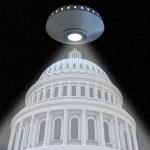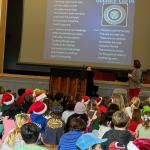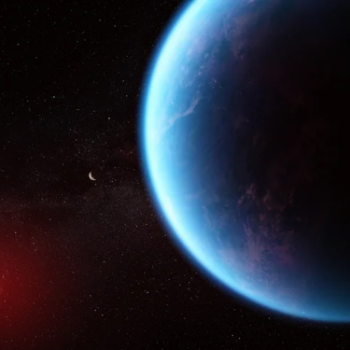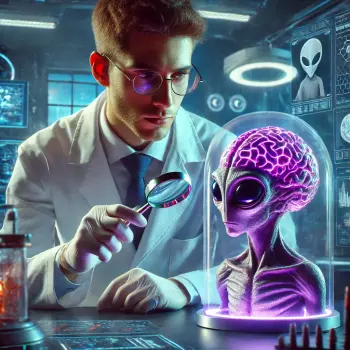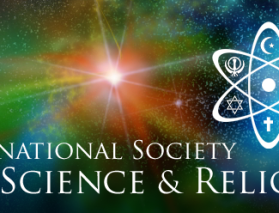Are UFOs Our Celestial Saviors?
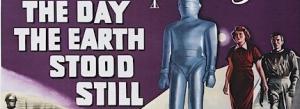
When writing the first edition of UFOs–God’s Chariots? back in 1976, it appeared to me that the UFO Phenomenon — the pehenomenon includes both UFOs as perceived objects plus their interpretation and cultural meaning — signaled the secularization of previous religious sensibilities. Instead of angels, we see flying saucers. Instead of God’s grace, we rely on technological progress. Instead of faith, we turn to science. So, modern Western culture began to ask: Are UFOs our celestial saviors?
I sliced the cultural meaning of the UFO experience into three overlapping models of interpretation. The UFO visitor comes as (1) an interstellar diplomat; (2) a research scientist; and (3) a celestial savior. It’s the third I wish to talk about here. But, briefly let’s look at the first two.
Model 1: the UFO as Interstellar Diplomat
First, exo-politics.
This past Tuesday evening, December 19, 2023, along with astrobiologist Seth Shostak, I offered my interpretations of “The Day the Earth Stood Still” (1951) at a SETI Movie Night. In my opinion, this is only one of two authentic UFO movies. The other is “Close Encounters of the Third Kind” (1977). All the rest are sci-fi projections of the cold war into space. What is distinctive about these two UFO films is that they reflect what UFO experiencers actually think, namely, ufonauts are coming to earth to heal the rifts of geopolitics, to gain and share advanced science, and to save Planet Earth from destruction by nuclear war.
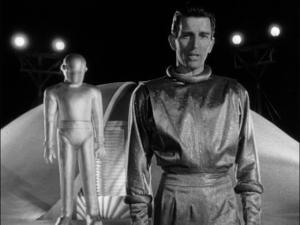 Klaatu’s speech at the conclusion of “The Day the Earth Stood Still” influenced the interpretation of actual UFO experiencers for decades to follow.
Klaatu’s speech at the conclusion of “The Day the Earth Stood Still” influenced the interpretation of actual UFO experiencers for decades to follow.
“The universe grows smaller every day, and the threat of aggression by any group anywhere can no longer be tolerated. There must be security for all or no one is secure. Now this does not mean giving up any freedom, except the freedom to act irresponsibly. Your ancestors knew this when they made laws to govern themselves and hired policemen to enforce them. We of the other planets have long accepted this principle. We have an organization for the mutual protection of all planets and for the complete elimination of aggression. The result is we live in peace, without arms or armies, secure in the knowledge that we are free from aggression and war, free to pursue more profitable enterprises…. if you threaten to extend your violence, this Earth of yours will be reduced to a burnt-out cinder. Your choice is simple. Join us and live in peace, or pursue your present course and face obliteration. We shall be waiting for your answer. The decision rests with you.”
From the heavens to the Earth comes a celestial messanger to teach us the way to world peace through the advanced technology of robotics. The heavenly aliens are not going to do the work of protecting us from ourselves. Rather, they teach us what to do and then demand that we make the decision and take the action to put an end to war.
That was the message 70 years ago. During the most recent decade, we’ve witnessed considerable political interest in the UFO phenomenon, renamed UAP or Unidentified Anomalous Phenomena. Larry Hancock has retrieved records to demonstrate that beginning in 1947 a significant UFO “reconnaissance targteting both strategic military bases and key atomic warfare facilities” became almost continuous [1]. In addtion to this historical retrieval, today’s ufologists along with scientists debate whether to send messages to ETI via METI International, whether governments should engage in “Disclosure” of evidence of extraterrestrial visitation, and whether the Eisenhower administration a half century ago made a treaty with at least one off-Earth civilization.
In short, exo-politics goes two directions. On the one hand, an interstellar diplomat travels to earth to help us discard our weapons and achieve peace on earth. On the other hand, we earthlings engage in political rhetoric to obtain dislcosure about this interstellar contact. In the meantime, the U.S. government seems concerned solely with national security. After that, nothing.
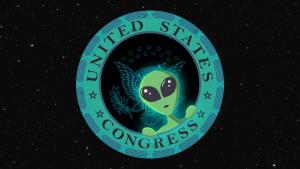
Model 2: the UFO as Research Scientist
Second, exo-science.
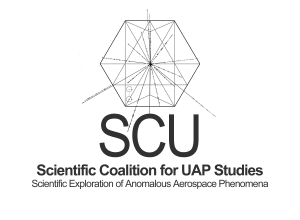 Here on Earth we respect our scientists, despite the fact that today’s scientists complain about misinformation and disinformation in the media. Over the last half decade scientists have formed organizations to muster resources for data gathering of UFO / UAP information. Here in this Patheos column, I’ve alluded frequently to Scientific Coalition for UAP Studies (SCU), the Society for UAP Studies, and Harvard’s Galileo Project.
Here on Earth we respect our scientists, despite the fact that today’s scientists complain about misinformation and disinformation in the media. Over the last half decade scientists have formed organizations to muster resources for data gathering of UFO / UAP information. Here in this Patheos column, I’ve alluded frequently to Scientific Coalition for UAP Studies (SCU), the Society for UAP Studies, and Harvard’s Galileo Project.
Scientists for the most part admire themselves for being the most highly evolved Homo sapiens on our planet. So, it follows: if ETI are more highly evolved than we are, then ETI must be more advanced than we in science and technology. This means ETI visiting Earth in spacecraft are accomplished scientists, among other things.
Aleady with the Betty and Barney Hill abduction case in 1961, followed by the abduction of Calvin Parker and Charles Hickson in Pascagoula, Mississipi, in 1977, and continuing to the present day, abducted earthlings report being given physical examinations by space visitors as if the extraterrestrial scientists are studying human anatomy. Extraterrestrial scientists are studying us. “Many abductees report that the aliens treat them indifferently and with cold efficiency,” observes Michael Zimmerman, “as if abductees were little more than laboratory animals”[2].
Much more could be said here. Suffice it to say that the first two models lead us to think that ETI are visiting Earth to share their advanced science as a way to help us through our political dead end streets and achieve Peace on Earth.
Model 3: The UFO as Celestial Savior
Third, exo-salvation.
“I believe in UFOs. I believe many UFOs have been the work of angles visiting our planet.” This is the testimony of Patheos columnist Kermit Zarley.
Does this make sense? Well, yes, sorta. If God’s heaven has been traditionally thought of as “up there,” and if “up there” now refers to stars and planets, and if beings from planets in Earth’s heavens are now visiting us, does this mean the ufonauts are divine? Or, if the teachings of our space visitors have mystical dimensions or transformatory power, might they connote the ancient concept of the gnostic redeemer? Is the ancient myth of saving knowledge descending from the heavenly realm of light alive and well in today’s UFO phenomenon?
George Adamski, famed UFO contactee of the 1950s, described his encounter with a Jesus-like ufonaut who came to Earth to persuade us to stop testing nuclear weapons. He came to teach earthlings how to accomplish Peace on Earth. From the heavens in a flying saucer, finally, we get Peace on Earth. ETI’s message to Adamski virtually repeated Klaatu’s message to earth: stop testing nuclear weapons! Stop war!
Two founders of SETI, scientists Carl Sagan and Frank Drake, also hoped for salvation coming to Earth from the skies. The two co-authored a Scientific American article, writing that contact with extraterrestrials “would inevitably enrich mankind beyond measure”[3]. Science saves. And in the event that terrestrial science falls short, then perhaps extraterrestrial science can get the job of salvation done.
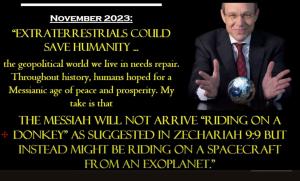
Are UFOs Our Celestial Saviors? Let’s Ask the ETI Myth
The affirmative answer to the question — are UFOs our celestial saviors? — takes the form of the ETI myth. According to the ETI myth, science saves. And if terrestrial science fails to save Earth, then perhaps extraterrestrial science can.
What is the ETI myth? In short, it is a conceptul set. It is a set of presuppositions.
This conceptual set first affirms belief that extraterrestrial intelligent beings exist. Second, at least some extraterrestrial beings are more advanced in evolution and technological progress. And, third, when ETI share their advancements with us on Earth we will be healed and improved and made better. It is a belief set without any direct empirical evidence. Yet, such a conceptual set or myth motivates our space research and our interpretation of the UFO phenomenon.
The ETI myth expresses the overconfidence we see in the belief that science saves. This doctrine that science saves is by no means intrinsic to science per se. Rather, it is promulgated by scientism, an ideology piled on top of science. Scientism dresses naked science in a faith system.
Spiritual — or Scientific — But Not Religious
Becoming a UFO Believer nicely replaces beliving in traditional religion. After all, science and technology have made marvelous progress.
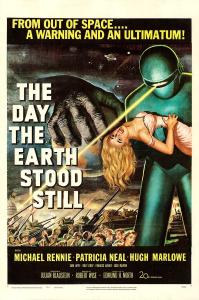
Many in our modern and emerging postmodern society like to think that they have graduated from religion, at least from institutional religion. They like to think of themselves as post-religious but still spiritual. Institutional religion seems narrow, dogmatic, absolutist. A post-religious spirituality, however, is attractive because it calls forth the experience of transcendence without the trappings of traditional dogma. “I am spiritual but not religious” has become a functional mantra. We might abbreviate “spiritual but not religious” as SBNR or, more affectionately, as SaBeener.
On the one hand, flying saucers appear to be machines, to be technological wonders. On the other hand, they exude religious valence. History of Religions scholar Diane Pasulka was “shocked,” she says, to learn that technology and spirituality might come in the same package.
“UFO contact events include supernatural and paranormal elements and influence people’s lives in ways that reorient them at the level of their values and core beliefs”[4].
What I am calling the “religious dimension” of the UFO phenomenon is in its own way a form of SBNR belief. When working out of the conceptual set we’ve identified as Model II, the Research Scientist, we in our own minds have left institutional religion and replaced it with science. Yet, curiously enough, we import religious sensibilities back into our science and dress our space visitors in SBNR clothing.
Conclusion
Our modern and emerging postmodern society may think it has left religion to decompose in the mystical marshes of the past. But in disguised form religious sensibilities continue to resonate endogenously within the myth that much of the worldwide scientific community has told itself. The scientist in the white lab coat has become the new messiah, the high priest of both terrestrial and extraterrestrial truth. And if terrestrial science threatens Earth with self-destruction through nuclear war, then perhaps extraterrestrial science can teach us the way to world peace.
Are UFOs Our Saviors? Well, which myth do you choose to believe?
SR 1180 UFO 10. Are UFOs Our Celestial Saviors?
UFOs and Aliens at the Vatican
Muslims, Christians, Scientists, and Extraterrestrial Aliens
A UFO for Christmas?
▓
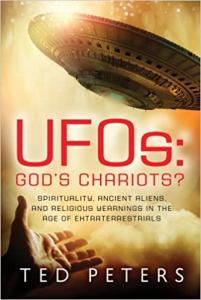
Ted Peters directs traffic at the intersection of science, religion, and ethics. Peters is an emeritus professor at the Graduate Theological Union, where he co-edits the journal, Theology and Science, with Robert John Russell on behalf of the Center for Theology and the Natural Sciences, in Berkeley, California, USA. He authored Playing God? Genetic Determinism and Human Freedom? (Routledge, 2nd ed., 2002) as well as Science, Theology, and Ethics (Ashgate 2003). Along with Martinez Hewlett, Joshua Moritz, and Robert John Russell, he co-edited, Astrotheology: Science and Theology Meet Extraterrestrial Intelligence (2018). Along with Octavio Chon Torres, Joseph Seckbach, and Russell Gordon, he co-edited, Astrobiology: Science, Ethics, and Public Policy (Scrivener 2021). Along with Arvin Gouw and Brian Patrick Green, he co-edited Religious Transhumanism and Its Critics (Lexington 2022). He is also author of UFOs: God’s Chariots? Spirituality, Ancient Aliens, and Religious Yearnings in the Age of Extraterrestrials (Career Press New Page Books, 2014). Look for his newest book, The Voice of Public Theology, a collection of previous articles. See his website: TedsTimelyTake.com.
Formerly, Ted served as Louisiana State Director of investigations for MUFON. Currently, he is a member of SCU (Scientific Coalition for UAP Studies).
▓
Notes
[1] Larry Hancock, Unidentified: The National Intelligence Problem of UFOs (Southlake TX: Treatise, 2017) 371.[2] Michael Zimmerman, “Encountering Alien Otherness,” The Concept of the Foreign: An Interdisciplinary Dialogue, ed. Rebecca Saunders (Landham MA: Lexington, 2003) 153-157, at 164.
[3] Carl Sagan and Frank Drake, “The Search for Extraterrestrial Intelligence, Scientific American 232 (1975) 80-89.
[4] D.W. Pasulka, Ecnounters: Experiences with Nonhuman Intelligences. (New York: St. Martin, 2023)



